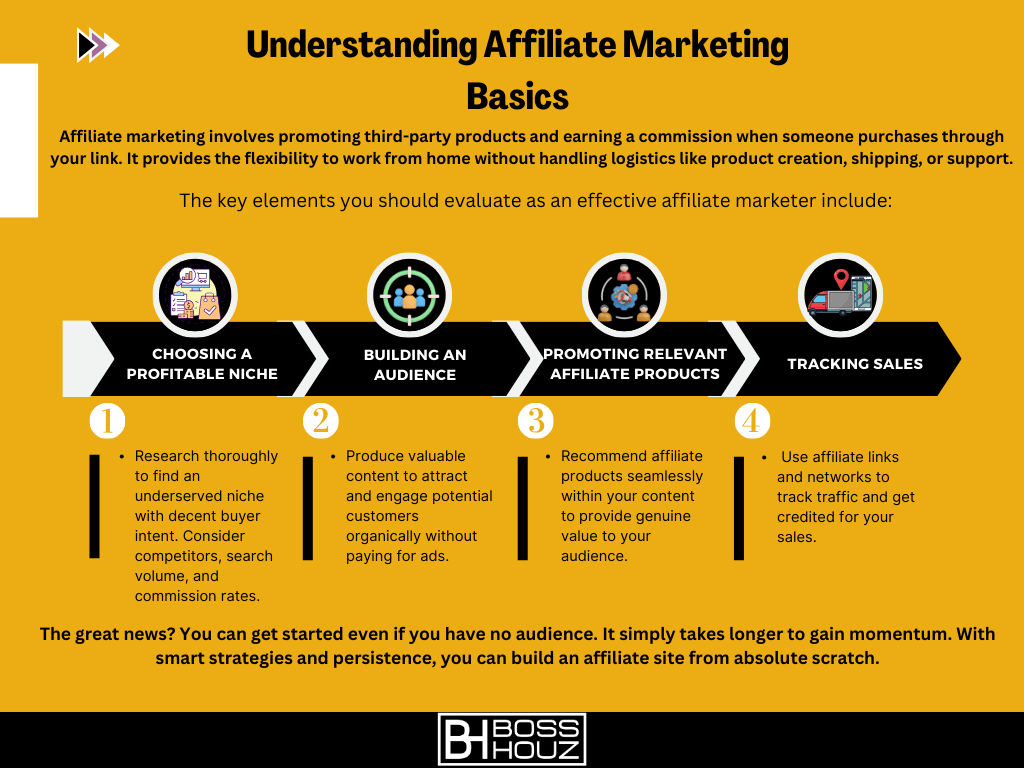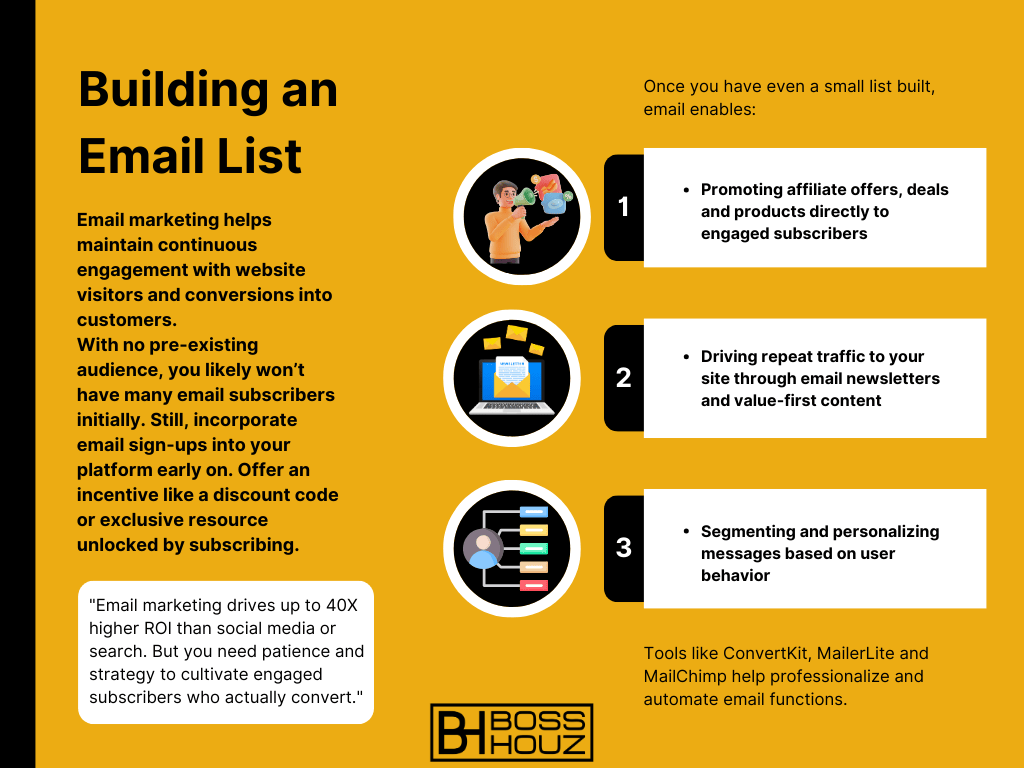Getting started with affiliate marketing when you have no audience or platform to leverage can seem intimidating. However, with the right strategies, it is possible to build a successful affiliate business from the ground up. This comprehensive guide will teach you everything you need to know, from choosing a niche to promoting affiliate products effectively even if starting completely from scratch.
Table of Contents
Understanding Affiliate Marketing Basics


Affiliate marketing involves promoting third-party products and earning a commission when someone purchases through your link. It provides the flexibility to work from home without handling logistics like product creation, shipping, or support.
The key elements you should evaluate as an effective affiliate marketer include:
- Choosing a profitable niche: Research thoroughly to find an underserved niche with decent buyer intent. Consider competitors, search volume, and commission rates.
- Building an audience: Produce valuable content to attract and engage potential customers organically without paying for ads.
- Promoting relevant affiliate products: Recommend affiliate products seamlessly within your content to provide genuine value to your audience.
- Tracking sales: Use affiliate links and networks to track traffic and get credited for your sales.
The great news? You can get started even if you have no audience. It simply takes longer to gain momentum. With smart strategies and persistence, you can build an affiliate site from absolute scratch.
Patience and commitment are key if starting affiliate marketing with no audience. Expect slow progress initially before you gain traction.”
Laying the Groundwork: Develop an Online Presence
Your first step is to establish some form of online presence—a platform to start engaging with your target audience.
The most popular options include:
- Building a niche website or blog. The best way to establish yourself as an authority in your niche. Provide value through content while directly promoting affiliate products.
- Leveraging social media. Platforms like Facebook Groups and Pinterest enable community building and content distribution around specific topics.
- Publishing on medium/substack. Contribute guest posts to build credibility and get in front of new audiences.
- Creating YouTube videos/podcasts. Great for establishing clout around your niche and personality. Enables affiliate product reviews too.
Weigh the pros and cons of each avenue to determine what works for your niche, skills, and bandwidth.
A niche site or blog tends to provide the most control for integrating affiliate products within your content accurately and contextually. This is why dedicated affiliate marketers strongly advocate for owning your platform, despite requiring more effort upfront.
“Building your own site or blog from scratch gives you full control over your branding, messaging, and affiliate integrations over the long run.”
Producing Value-Driven Content
Content is the lifeblood of affiliate marketing, especially if you’re starting from zero. Informative, engaging content attracts and converts website visitors into loyal followers and repeat customers.
Follow these best practices:
- Conduct keyword research to optimize your content for search visibility and target audience interests. Tools like Ahrefs, SEMRush, and Google Keyword Planner are invaluable here.
- Offer true value by addressing common pain points and questions around your niche. Avoid shallow articles just to populate your site. Provide depth and helpfulness to build authentic readership.
- Diversify content formats including long-form articles, list posts, reviews of affiliate products, interviews with influencers, and more. Cater to users’ preferences for consuming information.
- Promote content widely. Don’t just publish and pray. Actively promote your content across social platforms, niche forums, and any external channels at your disposal. Repurpose content too.
The goal here is to strike the right balance between value and promotion. If your content comes across overly self-promotional without helping the user, it won’t gain traction. But you need to incorporate relevant affiliate links at natural junctures to get paid for your efforts. This takes practice.
Leveraging SEO for Organic Website Growth
Search Engine Optimization (SEO) enhances your online visibility by improving your content and site to rank higher in search engines like Google. This attracts qualified organic traffic to your platform without any advertising costs.
For affiliate sites, the priorities for SEO include:
- Optimizing site architecture, page speed, technical elements for search crawler accessibility.
- Conducting keyword research to create relevant, search-friendly content.
- Earning backlinks from other authority sites in your space to signal expertise.
- Producing long-form, in-depth content on focused topics to rank for featured snippets and high-intent keywords.
SEO is complex, but even getting the basics right can accelerate organic growth. Study competitor sites in your niche to identify gaps, uncover winning topics, and benchmark your performance using SEO tools like Ahrefs and SEMRush.
“SEO combined with valuable content is how affiliate sites gradually gain steam and can ultimately thrive without ads or influencers. But you must lay this groundwork methodically.”


Capitalizing on Influencer Marketing Opportunities
Influencers can provide shortcuts to larger audiences. Especially when first starting out, look for relevant micro-influencers or industry experts to collaborate with.
Potential partnership opportunities include:
- Sponsored content: Pay influencers to feature your content or write dedicated posts on their blogs.
- Giveaways: Co-sponsor a giveaway with an influencer for contests, prizes, community growth.
- Product seeding: Provide free products to influencers to review or feature on their channels, ideally with a coupon code.
- Instagram takeovers: Guest post gorgeous imagery and offers from your brand on a popular Instagram account within your niche.
- Podcast interviews: Getting featured as an expert guest on popular podcasts exposes you to engaged new audiences.
Study various influencers and find ones who align closely with your niche, voice and values. Smaller nano or micro-influencers are often more affordable to work with as well.
“Choose giveaway partners and influencers carefully – bad matches can actually lose you credibility and trust.”
Strategically Leveraging Social Media
While organic social media reach is decreasing, platforms like Facebook, Pinterest and Instagram remain crucial both for organic community building and paid promotions.
- Hashtag research reveals related conversations and influencers to engage within your niche. Join in organically.
- Facebook Groups enable brand interactions and loyalty-building in a niche-specific community forum format.
- Pinterest referral traffic converts exceptionally well when optimized for affiliate content distribution.
- Instagram provides visually compelling formats for showcasing affiliate brands and products.
- TikTok introduces fun, interactive short-video capabilities to highlight and sell products.
Evaluate each platform specifically before investing resources into content creation or advertising. Ensure your metrics and ROI make sense.
“A strategic, nuanced approach is required to leverage each social media platform effectively at various stages of affiliate marketing growth.”
Employing Paid Advertising Sparingly
Paid advertising like Google Ads, Facebook Ads and native advertising provide the most direct path to gaining website traffic as a beginner affiliate. But tread carefully here:
- Low-quality paid traffic brings minimal long-term value. Focus on relevance over volume or vanity metrics alone.
- Continual spending without matching earnings causes cash burn and hampers sustainability.
- With persistence, organic SEO ultimately drives higher ROI long-term by converting visitors into loyal brand advocates.
Define clear ROI thresholds for your paid campaigns. For example, only scale budgets if you generate at least a 20% profit margin per conversion after ad spend. Be willing to pause underperforming campaigns immediately despite the temptation to scale them.
Affiliate marketing profits compound over time. Avoid depleted budgets or eroded credibility from poor paid promotions. Healthy cash reserves ensure you can keep producing value without revenue pressure.
“Beware of over-relying on paid ads as shortcut for immediate affiliate commissions. Prioritize audience quality and organic channels for continuity.”
Building an Email List


Email marketing helps maintain continuous engagement with website visitors and conversions into customers.
With no pre-existing audience, you likely won’t have many email subscribers initially. Still, incorporate email sign-ups into your platform early on. Offer an incentive like a discount code or exclusive resource unlocked by subscribing.
Once you have even a small list built, email enables:
- Promoting affiliate offers, deals and products directly to engaged subscribers
- Driving repeat traffic to your site through email newsletters and value-first content
- Segmenting and personalizing messages based on user behavior
Tools like ConvertKit, MailerLite and MailChimp help professionalize and automate email functions.
“Email marketing drives up to 40X higher ROI than social media or search. But you need patience and strategy to cultivate engaged subscribers who actually convert.”
Choosing Suitable Affiliate Programs
With affiliate marketing, you promote products from merchants and receive commissions per sale made.
Signing up for affiliate programs seems straightforward. But consider these factors to maximize conversions and commissions:
- High commission rates: The best affiliate programs offer commissions of 25-50% or more per sale. Recurring commissions are even better.
- Relevant products: Ensure a logical fit between your niche, content and the affiliate products you recommend. Mismatched products equal lower conversions.
- Trustworthy merchants: Research companies thoroughly before affiliating with them. Promoting questionable products or brands hurts your credibility.
- ** cookie duration**: Prefer affiliate programs providing 30-90 day or longer cookies. This credits your account if users purchase initially clicking your link.
- Coupons exclusives: Having special coupon codes or product discounts for your readers encourages purchases via your link instead of directly from the merchant site.
Curating a selective roster of on-brand affiliate partners tailored to your audience proves most profitable long-term. Join programs via affiliate networks like ShareASale, FlexOffers or ClickBank to simplify this.
“Getting approved for top-tier affiliate programs requires a solid platform and audience. Expect only niche or emerging programs initially until you prove yourself over time. “
Tracking Campaigns and Analyzing Performance
Meticulous tracking provides vital data to refine your affiliate strategy over time.
Essential metrics to monitor include:
- Website analytics: Traffic volume, visitor segments, landing/exit pages, time on site.
- Affiliate links: Impressions, clicks, referrals, conversions per link variation.
- Ad performance: Conversions, CPC, CTR performance indicators per campaign.
- Email engagement: Open rates, CTRs, conversions from each newsletter.
- Affiliate sales data: Confirmed commissions, customer geo-location, devices, time to purchase and more.
Regularly analyze this data to benchmark what’s working well—and what requires improvement. Software tools like Google Analytics, Refersion or Admitad simplify tracking across channels.
“Data-driven decisions separate successful affiliate marketers from stagnant sites. Track everything meticulously from day one before bad habits form.”
Emerging Affiliate Marketing Trends and Innovations
Like all digital marketing, affiliate techniques and strategies continue advancing rapidly. Stay updated on relevant innovations:
- AI and automation features help streamline traditionally manual processes like content curation, personalized emails and data-driven campaign management.
- Influencer networks formalize compensation models and match affiliates with relevant content creators easily.
- Interactive content gets higher engagement across platforms. Consider podcasts, videos, quizzes, surveys and more.
- Parnter marketplaces through tools like Impact or LeadDyno connect you with brands seeking promoted content, coupon codes, product seeding and more.
Evaluate such emerging solutions carefully before adoption. Ensure they provide specific value to your affiliate approach without unnecessary complexity or expense.


Maintaining Transparency and Trust
Unlike deceptive practices unfortunately common online, effective affiliate marketing relies on transparency with your audience.
That’s why it’s crucial to:
- Disclose affiliate relationships visibly. Forthright disclosures about affiliate earnings develop reader trust and actually maximize conversions.
- Vet products thoroughly before promotion. Never prioritize commissions over providing genuine value to your followers.
- Highlight product weaknesses in your content as well for balanced perspectives.
- Link prominently to privacy policies, disclosures and contact information so users can reach you if needed.
While affiliate commissions keep sites profitable and running, remember your long-term success ultimately depends on audience needs prioritization. Keep users’ best interests central.
Planning for Long Term Success Beyond Quick Wins
With the right niche, strategies and persistence, affiliate marketing can become a highly profitable full-time business. To progress towards this elusive goal, focus on:
- Expanding your niche reach across geographic and consumer verticals over time
- Building recurring revenue through evergreen content, email subscribers converted to raving fans.
- Minimizing overhead with lean operations even while scaling. Outsource selectively.
- Diversifying traffic across organic and paid channels so no single source dominates.
- Exploring additional monetization avenues like digital products/membership sites, brand sponsorships, speaking gigs or retention campaigns.
Measure your progress qualitatively too – by the value you provide consistently, the authority you build socially, and the customer satisfaction you deliver. These compound slowly but surely.
Ready to Start Your Affiliate Marketing Journey?
Even without an existing audience or platform, affiliate marketing remains a proven path to bootstrap an online business from scratch. Yes, progress can seem painfully slow initially before momentum picks up.
But by picking a defined niche, prioritizing valuable content and promotion strategies that serve your readers, and tracking data to continually optimize efforts, you set the stage for an thriving affiliate site over time.
With the right expectations, strategies and persistence, you can absolutely gain traction and ultimately thrive with affiliate marketing without relying on ads, external traffic sources or a big budget. Let this guide set you firmly down the path to long term success!








